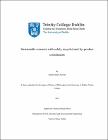| dc.description.abstract | Humans since ancient times have explored their surrounding materials throughout experiments and accumulated experience in the practice of construction, thereby recognizing the characteristics of building materials which can most effectively meet their needs.
In this context, concrete is one of the most important materials in human civilization, where it is used widely in construction, despite the fact that cement and aggregate production and transport cause the emission of large amounts of
carbon dioxide, which is the main cause of global warming. The production of one tonne of cement, for example, causes the emission of about 800 kg of this CO2. The growing demand for concrete constitutes a threat to the environment and its resources into the future. According to a market study by The Freedonia Group, in 2019 the world demand for cement was 5.1 billion tonnes which means that more than 2.5 billion tonnes of water and more than 11 billion tonnes of aggregates, both of which are scarce resources, will also be consumed. In addition, it is estimated that each year 1 billion tyres end their service life, and the steel industry is producing significant quantities of Ground granulated blast furnace slag (GGBS) as a recyclable material. The 2020 National Waste Report Ireland estimated the total quantity of construction and demolition waste collected in 2017
was 4.7 million tonnes which was collected by authorised waste collectors for treatment. 81% of this consisted of soil and stones, 8% of mixed construction and demolition waste, 7% is concrete, bricks, tiles and 4% are metals. On the other hand, Ireland also experiences from 750 to 1400mm of rainfall in a year. This thesis will use recycled car tyres in the form of chipped rubber, recycled concrete aggregates (RCA) coarse and fine, GGBS, Silica fume, 6.3 mm waste aggregate, recycled
Lithium from batteries, and rainwater to design a sustainable concrete. Combining these facts, the objective of this thesis is to describe the 100% substitution of these substances only to form sustainable concrete without compromising concrete mechanical properties.
This will demand the pre-treatment of these components to compensate for the natural strength loss due to their inclusion. Therefore, an innovative novel treatment method is selected for recycled concrete aggregates and chipped rubber to be separately treated and tested to mitigate the loss of strength in proposing a novel recycled activator for GGBS and silica fume. Then these waste recyclable materials are
combined in a concrete mix that is 100% recycled and, therefore, significantly more sustainable. | en |




